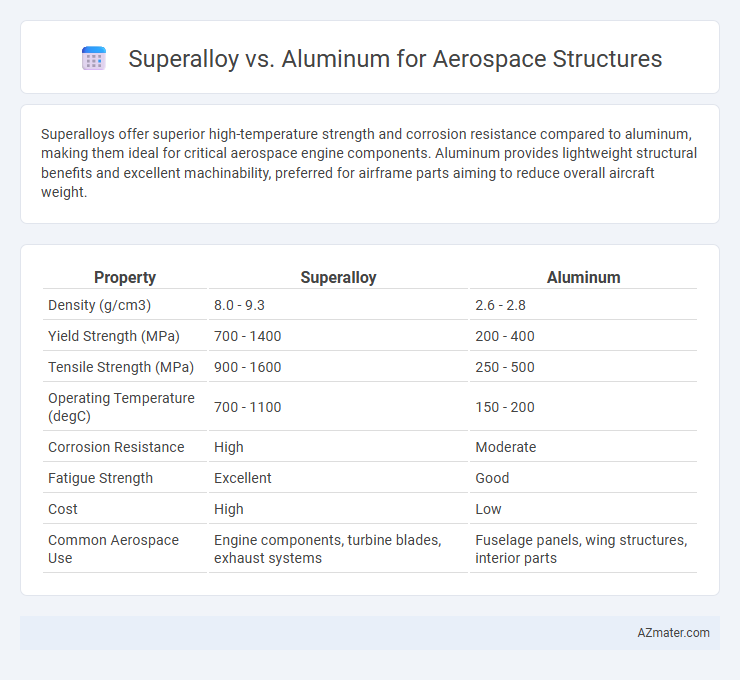Superalloys offer superior high-temperature strength and corrosion resistance compared to aluminum, making them ideal for critical aerospace engine components. Aluminum provides lightweight structural benefits and excellent machinability, preferred for airframe parts aiming to reduce overall aircraft weight.
Table of Comparison
| Property | Superalloy | Aluminum |
|---|---|---|
| Density (g/cm3) | 8.0 - 9.3 | 2.6 - 2.8 |
| Yield Strength (MPa) | 700 - 1400 | 200 - 400 |
| Tensile Strength (MPa) | 900 - 1600 | 250 - 500 |
| Operating Temperature (degC) | 700 - 1100 | 150 - 200 |
| Corrosion Resistance | High | Moderate |
| Fatigue Strength | Excellent | Good |
| Cost | High | Low |
| Common Aerospace Use | Engine components, turbine blades, exhaust systems | Fuselage panels, wing structures, interior parts |
Introduction: Superalloy vs Aluminum in Aerospace
Superalloys and aluminum represent two critical materials in aerospace structure design, each offering distinct advantages in strength, weight, and temperature resistance. Superalloys provide exceptional mechanical performance and corrosion resistance at high temperatures, making them ideal for engine components and hot sections of aircraft. Aluminum alloys contribute significantly to overall aircraft weight reduction due to their lightweight nature and excellent fatigue resistance, primarily used in airframe and structural parts.
Material Composition and Properties
Superalloys, primarily composed of nickel, cobalt, and chromium, exhibit exceptional high-temperature strength, oxidation resistance, and creep resistance, making them ideal for critical aerospace components subjected to extreme conditions. Aluminum alloys, rich in aluminum with additions of copper, magnesium, and zinc, offer low density, excellent corrosion resistance, and good strength-to-weight ratio, favoring their use in lightweight structural applications. The superior temperature tolerance of superalloys contrasts with aluminum's advantage in weight reduction, driving material selection based on specific aerospace performance requirements.
Strength-to-Weight Ratio Comparison
Superalloys exhibit exceptional strength and high-temperature resistance but have a higher density, resulting in a lower strength-to-weight ratio compared to aluminum alloys commonly used in aerospace structures. Aluminum alloys offer superior strength-to-weight ratios due to their low density and adequate mechanical strength, making them ideal for components where weight reduction is critical. Optimizing aerospace design often involves balancing superalloys' durability at extreme conditions with aluminum's lightweight advantages to enhance overall structural performance.
Corrosion and Oxidation Resistance
Superalloys exhibit superior corrosion and oxidation resistance compared to aluminum, making them ideal for aerospace structures exposed to high-temperature and harsh environmental conditions. The cobalt, nickel, and chromium content in superalloys forms a stable oxide layer that prevents further degradation, whereas aluminum alloys, while lightweight, are more prone to pitting and surface corrosion when exposed to saltwater and acidic atmospheres. This enhanced durability of superalloys results in longer service life and reduced maintenance costs for critical aerospace components.
Thermal Stability and Performance
Superalloys offer superior thermal stability compared to aluminum, maintaining mechanical strength and corrosion resistance at temperatures exceeding 700degC, crucial for aerospace engine components. Aluminum alloys, while lightweight and cost-effective, typically lose structural integrity above 200degC, limiting their use in high-temperature zones. Advanced aerospace structures often integrate superalloys in turbine blades and exhaust systems to ensure durability and performance under extreme thermal stress.
Manufacturability and Processing
Superalloys offer superior high-temperature strength and corrosion resistance critical for aerospace structures but pose challenges in manufacturability due to their high melting points and tendency for work hardening, requiring specialized processing techniques like vacuum induction melting and precision machining. Aluminum alloys, widely favored for aerospace components, provide easier machinability and formability with lower melting points, enabling faster and more cost-effective manufacturing through processes such as extrusion, stamping, and conventional machining. The trade-off in processing complexity means superalloys demand longer cycle times and advanced equipment, while aluminum accelerates production but may require additional treatments for strength and durability in high-stress aerospace applications.
Cost Analysis and Economic Impact
Superalloys offer superior high-temperature strength and corrosion resistance compared to aluminum, but their significantly higher raw material and processing costs impact overall aerospace manufacturing expenses. Aluminum, while less expensive and easier to machine, often requires additional treatments and replacements due to lower durability, influencing long-term maintenance costs. The economic impact balances upfront investment in superalloys with potential savings from enhanced performance and reduced lifecycle maintenance in aerospace structures.
Applications in Aerospace Structures
Superalloys exhibit exceptional high-temperature strength and corrosion resistance, making them ideal for critical aerospace components such as turbine blades, exhaust systems, and jet engine parts. Aluminum alloys offer lightweight properties and excellent fatigue resistance, commonly used in aircraft fuselage, wing structures, and landing gear to improve fuel efficiency and handling. The strategic application of superalloys and aluminum optimizes performance by balancing durability, weight, and thermal stability in aerospace structures.
Sustainability and Environmental Considerations
Superalloys, characterized by exceptional strength and resistance to extreme temperatures, offer durability and longevity in aerospace structures, reducing the frequency of part replacements and thereby minimizing material waste. Aluminum, lightweight and highly recyclable, significantly lowers fuel consumption through weight reduction, contributing to decreased carbon emissions during aircraft operation. Sustainable aerospace design increasingly favors aluminum for its recyclability and lower embodied energy, while superalloys excel in critical high-stress components where long-term performance outweighs environmental disposal impact.
Future Trends in Aerospace Materials
Superalloys and aluminum remain critical materials in aerospace structures, with superalloys offering exceptional high-temperature strength and corrosion resistance, while aluminum provides lightweight properties essential for fuel efficiency. Future trends emphasize the development of advanced superalloys with enhanced thermal stability and the integration of aluminum-lithium alloys to reduce structural weight further. Innovations in additive manufacturing and material hybridization are driving the evolution of aerospace materials, optimizing performance, durability, and sustainability in next-generation aircraft designs.

Infographic: Superalloy vs Aluminum for Aerospace Structure
 azmater.com
azmater.com